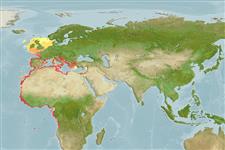Common names from other countries
>
Scombriformes (Mackerels) >
Scombridae (Mackerels, tunas, bonitos) > Scombrinae
Etymology: Orcynopsis: Greek, orkynos, -ou = a kind of tunna + Greek, opsis = similar to (Ref. 45335).
Environment: milieu / climate zone / depth range / distribution range
Ecologia
marinhas; estuarina; oceanódromo (Ref. 51243); intervalo de profundidade 4 - ? m (Ref. 122150). Subtropical; 60°N - 13°S, 18°W - 36°E
Eastern Atlantic: Oslo, Norway south to Dakar, Senegal but the range is centered in the southern Mediterranean Sea. Not known from Madeira, the Canary Islands or Cape Verde.
Comprimento de primeira maturação / Tamanho / Peso / Idade
Maturity: Lm 75.0, range 70 - 80 cm
Max length : 130 cm FL macho/indeterminado; (Ref. 168); common length : 90.0 cm FL macho/indeterminado; (Ref. 168); peso máx. publicado: 13.1 kg (Ref. 168)
Espinhos dorsais (total) : 12 - 14; Raios dorsais (total) : 12 - 15; Raios anais : 14 - 16. Mouth rather large, upper jaw reaching to hind margin of eye. Laminae of olfactory rosette 25 to 28. Interpelvic process small and bifid. Body naked behind the well developed corselet. Swim bladder absent. Vertebrae 17 or 18 precaudal plus 19 to 21 caudal, total 37 to 39. Anterior three quarters of first dorsal fin black.
Adults are neritic, confined primarily to temperate waters, but juveniles may be encountered in waters of up to 30°C. Form small schools at the surface so that the first dorsal fin stands out of the water like that of sharks, also frequently associated with birds. Feed on small fishes, especially sardines, anchovies, jacks, mackerel, bogue and others. Eggs and larvae are pelagic (Ref. 6769). Marketed canned or frozen.
A female weighing 5 or 6 kg may carry some 500 to 600,000 eggs which are spawned in portions.
Collette, B.B. and C.E. Nauen, 1983. FAO Species Catalogue. Vol. 2. Scombrids of the world. An annotated and illustrated catalogue of tunas, mackerels, bonitos and related species known to date. Rome: FAO. FAO Fish. Synop. 125(2):137 p. (Ref. 168)
Status na Lista Vermelha da UICN (Ref. 130435)
CITES (Ref. 128078)
Not Evaluated
Ameaça para os humanos
Harmless
Uso pelos humanos
Pescarias: pouco comercial; peixe esportivo: sim
Ferramentas
Relatórios especiais
Baixar XML
Fontes da internet
Estimates based on models
Preferred temperature (Ref.
115969): 12.5 - 23.5, mean 16.3 (based on 264 cells).
Índice de diversidade filogenética (Ref.
82804): PD
50 = 1.0000 [Uniqueness, from 0.5 = low to 2.0 = high].
Bayesian length-weight: a=0.00955 (0.00464 - 0.01966), b=3.05 (2.88 - 3.22), in cm Total Length, based on LWR estimates for this (Sub)family-body shape (Ref.
93245).
Nível Trófico (Ref.
69278): 4.5 ±0.80 se; based on food items.
Resiliência (Ref.
120179): médio(a), tempo mínimo de duplicação da população 1,4 - 4,4 anos (Assuming tm<=4).
Fishing Vulnerability (Ref.
59153): Very high vulnerability (87 of 100).
Climate Vulnerability (Ref.
125649): Moderate to high vulnerability (52 of 100).
